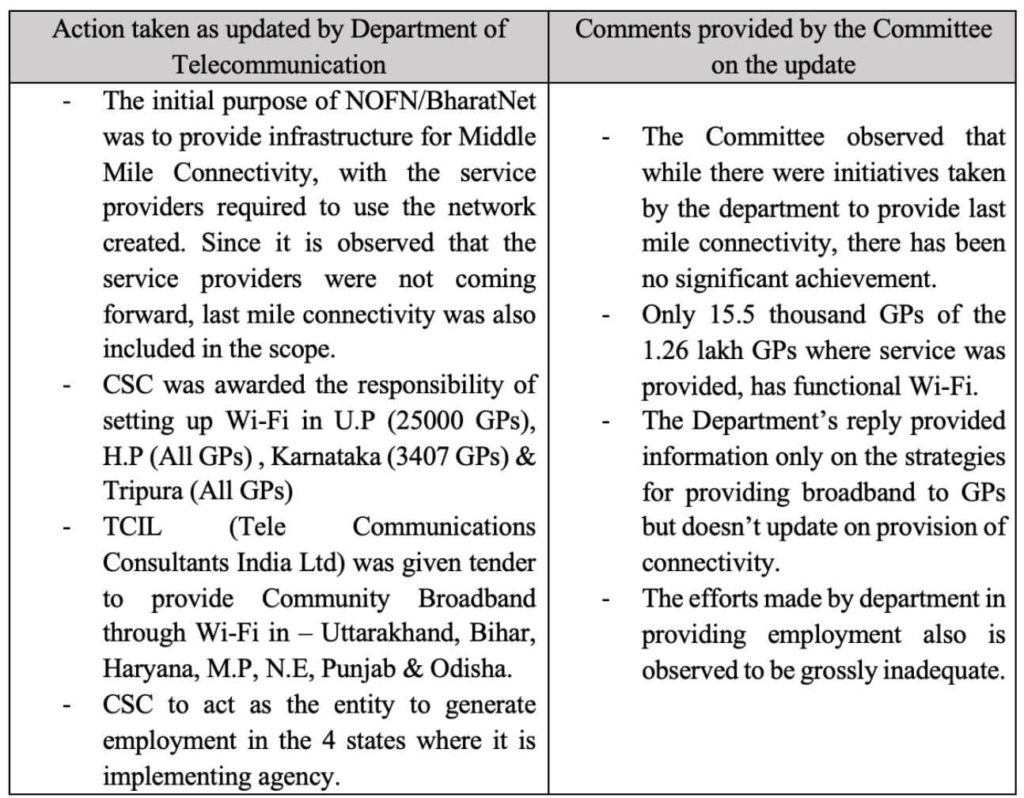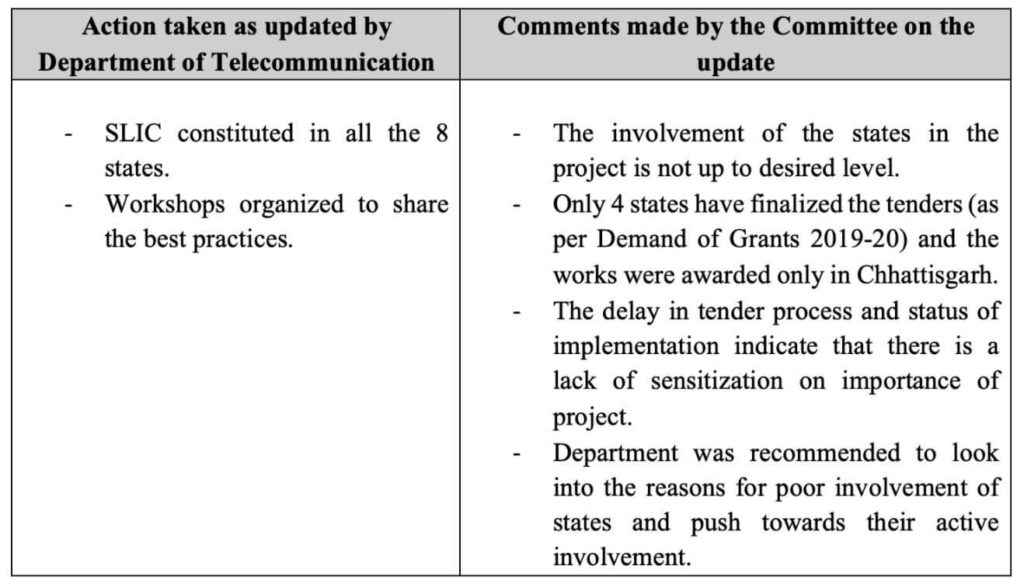The Prime Minister Narendra Modi during his recent Independence Day address, set 2023 as the target to connect all the panchayats by optical fiber. The target year for this has pushed multiple times by the UPA & now the NDA. Here is what the standing committee observed regarding the progress of ‘Bharat Net’.
In his Independence Day address to the nation on account of 74th Independence Day, Prime Minister Narendra Modi announced that in the next 1000 days, all the villages will be connected by optical fiber cable. He has further updated that around 1.5 lakh gram panchayats have been connected with optical fiber in the last 5 years.

Providing Broadband connectivity to all the 2.5 lakh Gram Panchayats in India is part of the Bharat Net Programme by the NDA-II government, which is a continuation of an earlier programme, the National Optical Fibre Network (NOFN) initiated by UPA government in 2011. Factly has earlier written a story on Bharat Net Programme.
The program initially had an ambitious target of achieving the connectivity to all the gram panchayats by 2013, which was later revised to 2017. As per PM’s address, the deadline now shifts to nearly another three years, which is 2023.
Responding to a question in Lok Sabha on 05 February 2020, the Government of India stated various reasons for the delay in implementation of the project, which include – delay in the initial commencement of project, delay with the implementation in the 8 states which are under State-led Model etc.

Earlier, in August 2018, the Standing Committee on Information Technology, presented its 50th Report – ‘Progress of Implementation of Bharath Net’ during the 16th Lok Sabha. As part of the report, the committee made certain observations and recommendations for the government to take action. As a follow-up to this , Standing Committee on Information Technology for 17th Lok Sabha presented its Action Taken Report in Lok Sabha on 20 March 2020. Here is a review of these reports.
The Committee did not accept Government’s response on 6 of the 21 recommendations/observations.
There were 21 recommendations/observations made as part of the 50th report i.e. ‘Progress of Implementation of Bharat Net’ tabled in Rajya Sabha on 07 August’2018. The Department of Telecommunication, under whose aegis the programme is being implemented provided their Action Taken Notes on 20 January 2019.
The Standing Committee on Information Technology (2019-20) was constituted under the Chairmanship of Dr. Shashi Tharoor, Congress MP from Thiruvananthapuram. The Standing Committee reviewed the action taken by the government and submitted their observations to the parliament on 20 March 2020.
Based on the action taken by the government, the committee has categorized the 21 recommendations into four categories.

In this story, we take a look at the 6 recommendations or observations for which the Standing Committee did not accept the response provided by the government on the action taken.
Committee observed that the last mile connectivity is important for utilization of the network
Recommendation # 3 by the Committee in its original report was regarding Wi-Fi connectivity in Gram Panchayats. Its recommendations and observations include:
- Bharat Broadband Network Limited (BBNL) can go for Viability Gap Funding (VGF) in Public Private Partnership Mode to cover all the Gram panchayats to provide Wi-Fi or other Broadband connectivity.
- It observed that ‘Last Mile Connectivity’ was not in scope of Bharat Net programme that was approved by the Cabinet, with it being added only in Juy’2017.
- They acknowledged the updates provided by the Telecom Department regarding CSC-SPV being awarded the tender to setup various hotspots in UP & Himachal Pradesh along with State Government taking up the initiative of the same in Rajasthan.
- It made a key observation that since 1.1 lakh GPs have the service available, the focus should be on ensuring on utilization of these services and last mile connectivity.
- It also recommended that scope of encouraging Village Level Entrepreneurs, creating employment and generating revenue should also be explored while setting up the Wi-Fi hotspots.
The Department of Telecommunication provided an update on the action taken on these recommendations and observations. The Standing Committee has made certain comments seeking more information and clarity from the government.

Lack of progress in involvement of States with the project
Standing Committee was appraised that the non-involvement of the states under Phase-1, has led to distancing of the states which further resulted in the slow progress and low utilization of infrastructure. Based on this the committee made certain recommendations to engage states in a more active role.
- Modified strategy as approved by Union Government, in which 61,523 GPs will be provided connectivity through a State Led Model, in the states of Maharashtra, Gujarat, Chhattisgarh, Jharkhand, Odisha, Andhra Pradesh, Telangana & Tamil Nadu.
- States to take up responsibility of – Network management, operations, maintenance etc.
- MOU signed between 4 parties – USOF (Universal Service Obligation Fund), BBNL, States & State Implementing Agency.
- State Level Implementation Committee to be formed in all the states, in line with SLIC in Maharashtra.

Committee asked the department to have a thorough review regarding the low performance of RailTel
At the time of the original report, the committee was appraised, and it took cognizance of the issues in the performance of RailTel in the allocated projects. Based on this, two observations/recommendations (10 & 11) were made.
First observation (No.10) was in regard to RailTel’s performance in the allocated States & UTs.
- Only 78.1% of target was achieved by RailTel during Phase I, compared to 96.5% by BSNL and 83.7% by PGCIL.
- The challenges identified (especially in Gujarat) were – getting RoW permissions, non-feasible FPOIs by BSNL, delay in taking over maintenance by BSNL.
- Since most of the issues are resolved, the committee expected that RailTel might have achieved the target.
Committee has also made another observation/recommendation regarding RailTel specific to the North East.
- Geographical and other challenges in the North-East are hampering the progress of RailTel’s work.
- Weak OFC link between Districts & Blocks to be strengthened.
- TCIL to conduct a study and develop a Project report to build reliable high-speed network.
- Urgent need to change the implementation strategy of RailTel in North East region.

The performance of RailTel in some states more than 100 since the fiber was laid to more villages than initially planned.
Need for more States/UTs to align with Right of Way Rules
Indian Telegraph Right of Way Rules, 2016 were framed to provide RoW permissions for both underground and over the ground infrastructure development, in a time-bound, simple and transparent manner.
The committee was informed by the Department that RoW agreements were concluded with all the states. As on 01 May 2018, there were 296 RoWs pending, which affect 1241 GPs.
The committee in its recommendations as part of ‘Progress of Implementation of Bharat Net’ report, advised that a Single Window Clearance System needs to be in place as the project is being impeded due to the lack of coordination between the implementing agencies. In its update, the department has stated that as on 04 January 2019, there are only 115 cases affecting 481 GPs that are pending.

However, no update was provided on constitution of a Single Window System. The committee, while expressing satisfaction on the decrease in pending issues, has again reiterated the need for setting up a Single Window Clearance System and urged the department to make efforts in this direction.

Earliest need for framing a Draft Common Duct Policy
The Standing Committee has recommended laying of Common Duct as a measure to avoid frequent cut and damage to the cables. It has recommended that a Draft policy needs to be framed at the earliest as it would require the coordination and cooperation of different States & agency for common implementation.
Telecommunication Department has provided an update that a High-Powered Committee under Chairmanship of Secretary (Telcom) along with Secretaries of Power, Petroleum and members from Engineering- Railway Board was formed. They have drafted a report after due deliberations and submitted it to Ministry of Road Transport & Highways.

The Standing Committee advised the department to impress upon the concerned agencies for implementation of the report and take up pilot projects.
All these 6 recommendations were sent back by the Standing Committee to the Ministry of Telecommunication for further information and clarifications. There are 10 recommendations which have been accepted by the government and another 5 for which the response provided was of interim in nature. We will take a look at the action taken by the government for these recommendations in the next story.
Featured Image: Last Mile Connectivity


